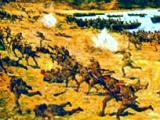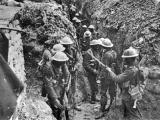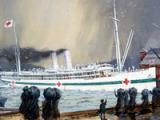In a well-planned operation which contrasted sharply with those mounted earlier in the Gallipoli campaign, Allied troops were successfully withdrawn from Anzac Cove and Suvla Bay between 15 and 20 December.
Gallipoli Campaign
Events In History
Hill 60 was the last offensive action fought by the New Zealanders during the Gallipoli campaign. The ‘abominable little hill’, as it was dubbed by Brigadier-General Andrew Russell, saw bitter fighting between New Zealand and Ottoman troops in late August 1915.
The high point of the New Zealand effort at Gallipoli, the capture of Chunuk Bair underlined the leadership qualities of Lieutenant-Colonel William Malone.
The first large group of Gallipoli wounded to return to New Zealand arrived in Wellington on the troopship Willochra as part of a draft of around 300 men.
Each year on Anzac Day, New Zealanders and Australians mark the anniversary of the Gallipoli landings of 25 April 1915.
Articles
Anzac Day
First observed in 1916, Anzac Day - 25 April - commemorates those killed in war and honours returned servicemen and women. The ceremonies held at war memorials around the country, and in places overseas where New Zealanders gather, are rich in tradition and ritual. Read the full article
Page 1 - Anzac Day
First observed in 1916, Anzac Day - 25 April - commemorates those killed in war and honours returned servicemen and women. The ceremonies held at war memorials around the country,
Page 2 - The Anzacs
The word Anzac is part of the culture of New Zealanders and Australians. The word conjures up a shared heritage of two nations, but it also has a specific meaning, dating from
Page 3 - The ceremony
The Anzac Day ceremony of 25 April is a form of military funeral and follows a specific pattern. The day's ceremonies have two major parts: one at dawn and another later in the
Page 4 - The making of Anzac Day
Anzac Day was made a half-day holiday in 1916, when the pattern of the day's events began to be
The Gallipoli campaign

Each year on Anzac Day, New Zealanders (and Australians) mark the anniversary of the Gallipoli landings of 25 April 1915. On that day, thousands of young men, far from their homes, stormed the beaches on the Gallipoli Peninsula in what is now Türkiye. Read the full article
Page 1 - The Gallipoli campaign
Each year on Anzac Day, New Zealanders (and Australians) mark the anniversary of the Gallipoli landings of 25 April 1915. On that day, thousands of young men, far from their
Page 2 - Gallipoli in brief
The Ottoman Empire entered the war on the side of the Central Powers. New Zealand and Australian troops supported British and French soldiers in an attempt to capture the
Page 3 - Invasion
Allied forces landed on the Gallipoli Peninsula on 25 April 1915. British (and later French) forces made the main landing at Cape Helles on the southern tip of Gallipoli, while
Page 4 - Stalemate
By 29 April, the battle of the landing was over; both sides had fought themselves to a standstill. While the New Zealanders and Australians had established a beachhead at Anzac
Page 5 - The Sari Bair offensive
As the futile attacks continued at Helles, the Allies began looking at alternative strategies to break the deadlock. Lieutenant-General Birdwood, the ANZAC commander, formulated a
Page 6 - Evacuation
Hill 60 was the last major Allied attack at Gallipoli. The failure of the August offensive raised more questions about the future of the campaign, especially in light of the
Page 7 - Soldiers' experience
Life for the New Zealand soldier on Gallipoli was tough. They struggled with the harsh environment, living and fighting amongst the deep ravines and high cliffs that towered above
Page 8 - Gallipoli timeline
Timeline showing key events related to New Zealand's involvement in the Gallipoli
Page 9 - 25 April 1915: Anzac landing timeline
This timeline provides a detailed breakdown of what happened and when during the Gallipoli landings at Anzac Cove on 25 April
Page 10 - Gallipoli biographies
Find out more about some of the New Zealanders involved in the Gallipoli campaign between April 1915 and January 1916.
Page 11 - Further information
Recommended links and further reading about
First World War - overview

Archduke Franz Ferdinand, heir to the throne of the Austro-Hungarian Empire, and his wife Sophie were assassinated in the Bosnian city of Sarajevo. This was a key event in sparking the Great War of 1914–18. Read the full article
Page 4 - New Zealand goes to war
Before the outbreak of war, Prime Minister W.F. Massey had made it clear that New Zealand’s main contribution would be supplying troops to the major theatre of conflict. But
Memorials register
Find exact locations and further information for more than 1000 memorials throughout New Zealand. Read the full article
Page 3 - Living memorials projects
Scion, the Crown Research Institute for the forestry sector, has provided approximately 50 seedlings to be planted around New Zealand as First World War
British Empire
Key information and statistics about countries who fought as part of the British Empire during the First World War Read the full article
Page 2 - Dominion of New Zealand
Facts and statistics about New Zealand during the First World
Page 3 - Commonwealth of Australia
Key information and statistics about the Commonwealth of Australia during the First World
Page 5 - British India
Facts and statistics about India during the First World
The Ottoman Empire
Few Kiwis today know much about one of our main First World War enemies, the Ottoman Empire - a sophisticated but often forgotten empire whose soldiers fought against New Zealand troops for four years in the Gallipoli, Sinai and Palestine campaigns. Read the full article
Page 1 - The Ottoman Empire
Few Kiwis today know much about one of our main First World War enemies, the Ottoman Empire - a sophisticated but often forgotten empire whose soldiers fought against New Zealand
Page 5 - Ottoman Empire at war
How the Ottoman Empire fared during the First World War
Page 12 - The Turkish soldier's experience
Mehmetçik – ‘Little Mehmet’ – was an affectionate Turkish nickname for Ottoman (Turkish)
Wellington Mounted Rifles Regiment timeline
Timeline for the Wellington Mounted Rifles in 1915 Read the full article
Page 1 - 1915
Timeline for the Wellington Mounted Rifles in
Māori in the NZEF
More than 2000 Maori served in the Māori Contingent and Pioneer Battalion during the First World War Read the full article
Page 2 - Maori Contingent at Gallipoli
The first Maori Contingent sailed from Wellington aboard the SS Warrimoo in February 1915. The contingent served on the Gallipoli
Page 3 - Pioneer Battalion
In early 1916 the Maori Contingent ceased to exist and was replaced by the New Zealand Pioneer
Merchant marine
On 3 September New Zealand honours Merchant Navy Day. Here we explore the little-known but vital role played by the merchant marine during the First World War, when these civilian seafarers often found themselves in the front line of the war at sea. Read the full article
Page 4 - Hospital ships
In May 1915, as casualties mounted at Gallipoli, the government chartered a hospital ship, the Union Company's 5282-ton trans-Tasman liner
Auckland Mounted Rifles Regiment timeline
The Auckland Mounted Rifles Regiment actions in 1915, from Sinai to Gallipoli Read the full article
Page 1 - 1915
The Auckland Mounted Rifles Regiment actions in 1915, from Sinai to
Canterbury Mounted Rifles Regiment timeline
In May the CMR and the rest of the New Zealand Mounted Rifles Brigade (NZMR) are thrown – as infantry – into the desperate struggle to seize the commanding heights of the Gallipoli Peninsula. In the next four months the regiment suffers more than half of all its casualties in the war. Read the full article
Page 1 - 1915
In May the CMR and the rest of the New Zealand Mounted Rifles Brigade (NZMR) are thrown – as infantry – into the desperate struggle to seize the commanding heights of the
First World War art
During the First World War official and unofficial New Zealand war artists produced a wide range of works depicting this country's war effort. These works later became part of New Zealand's National Collection of War Art. Read the full article
Page 2 - Unofficial war art
New Zealand soldiers used art to interpret the experience of the war for an audience of noncombatant civilians. Civilian artists in turn produced works that responded to and
The Salonika campaign
23 October is the anniversary of the 1915 sinking of the Marquette with the loss of 32 New Zealanders, including 10 nurses. They were en route from Egypt to the Greek port of Salonika as New Zealand’s contribution to the little-known Allied campaign in the Balkans Read the full article
Page 2 - Lemnos
The Balkan campaign of the First World War (also known as the Salonika or the Macedonian campaign) came about because of the changing strategic aims of the Allies and Central
NZ's First World War horses
Between 1914 and 1916 the New Zealand government acquired more than 10,000 horses to equip the New Zealand Expeditionary Force. They served in German Samoa, Gallipoli, the Middle East and on the Western Front. Of those that survived the war, only four returned home. Read the full article
Page 5 - Egypt and Gallipoli
Some draught horses accompanied the divisional artillery and transport and supply units to Gallipoli in April 1915 to assist with their work. But the conditions proved unsuitable
Hospital ships

The Maheno and Marama were the poster ships of New Zealand's First World War effort. Until 1915 these steamers had carried passengers on the Tasman route. But as casualties mounted at Gallipoli, the government - helped by a massive public fundraising campaign - converted them into state-of-the-art floating hospitals. Read the full article
Page 3 - Gallipoli calls
The terrible casualty rate of the Gallipoli campaign spurred Governor Liverpool to raise funds for New Zealand hospital
Page 4 - Civilians at Gallipoli
The Maheno arrived in the Mediterranean in time for the Allies’ bloody late August 1915 offensives to find that not much had improved since the April
The Post and Telegraph Department at war
The Post and Telegraph Department (the government agency from which New Zealand Post, Telecom and Kiwibank are descended) was crucial to this country’s participation in the First World War. Read the full article
Page 4 - Communications at Gallipoli
Whether it was signallers conveying orders to the front line or mail services being provided for soldiers, men from the Post and Telegraph Department played a vital role during














































































































































